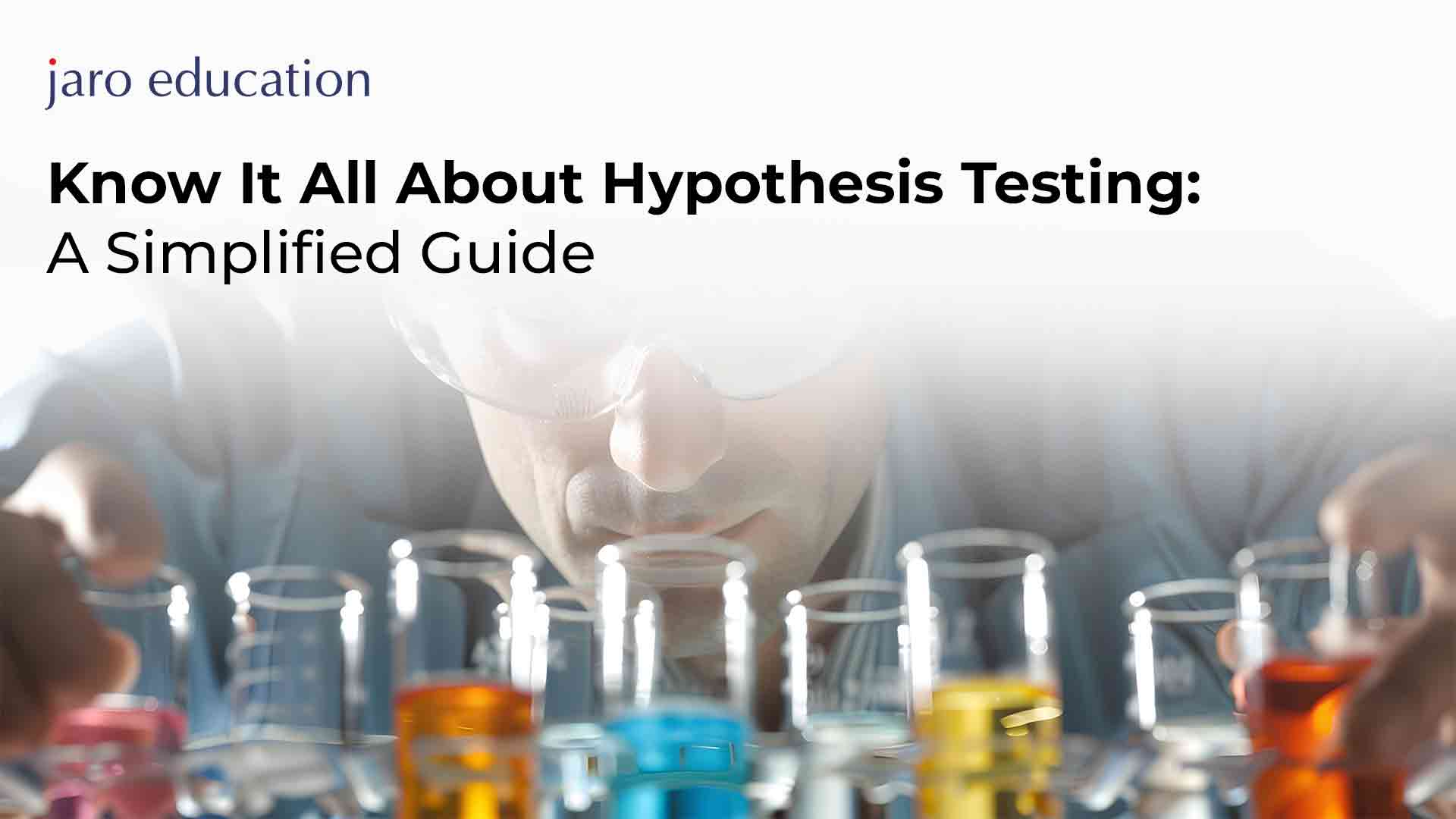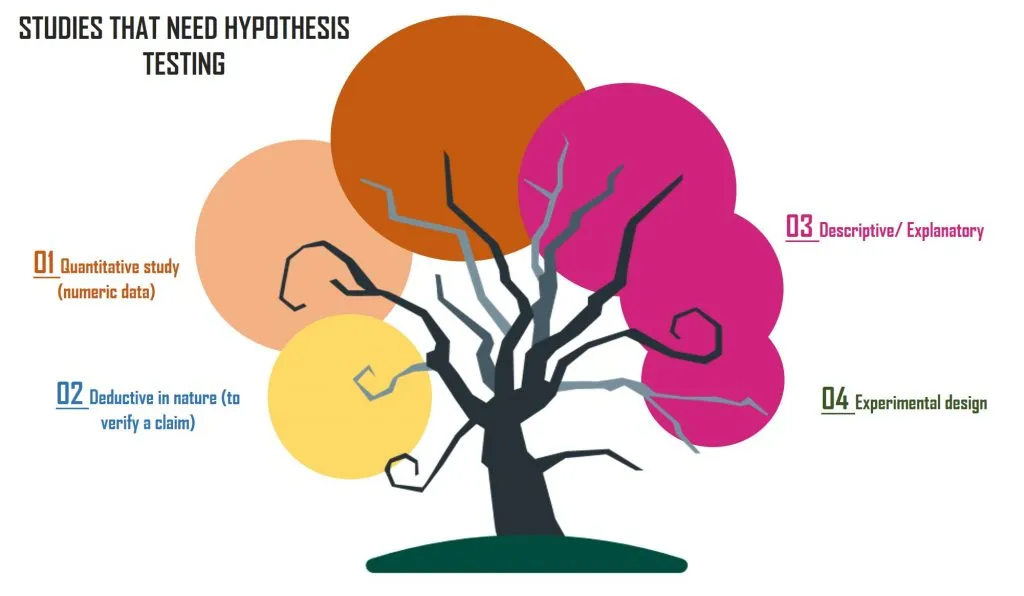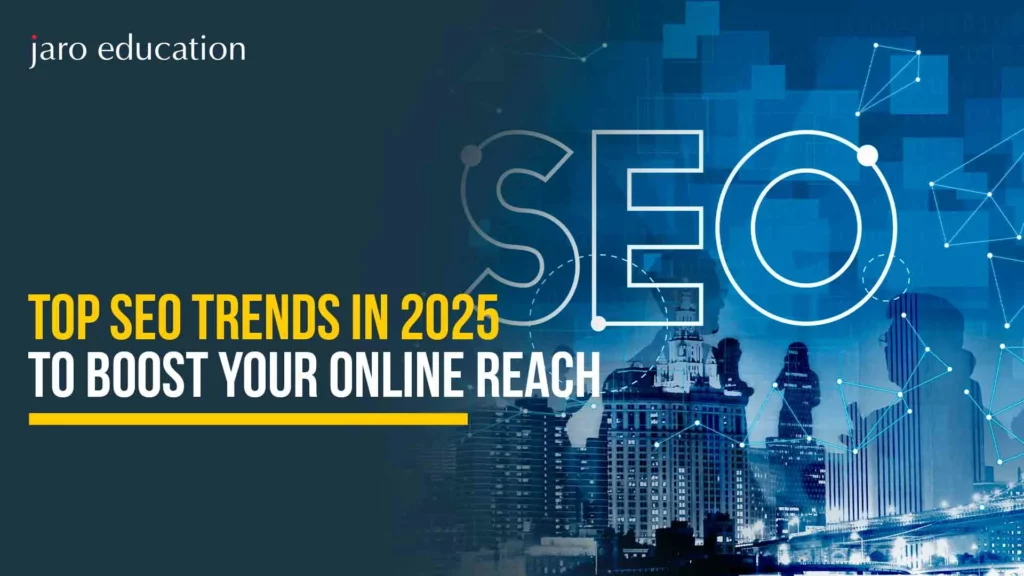Know It All About Hypothesis Testing: A Simplified Guide
Table of Contents

- jaro education
- 13, August 2024
- 3:00 pm
Overview
Hypothesis testing is one of the major methods in the grand scheme of statistics. It assists in deriving data-driven decisions, evaluating theories, and inferring meaningful conclusions from data. But what is hypothesis testing, and why is it so important in statistics? For those who want to learn and enhance their skills, the IIM Nagpur PG Certificate Programme in Data Science for Business Excellence and Innovation offers the perfect platform for learning from professionals, gaining hands-on experience, and moving up the value chain.
Introduction to Hypothesis Testing
Hypothesis testing is a means to make decisions about population properties based on the information derived from a sample. It simply provides a basis for the testing of assumptions or hypotheses made about a certain parameter in a population. Statement of the whole process involves a null hypothesis denoted by H0 and an alternative hypothesis denoted by H1, followed by the collection of data and subsequent analysis to see whether it favours the rejection of the null hypothesis in favour of the alternative.
In other words, hypothesis testing gives the answers to such questions as:
- Does a new drug improve patient outcomes?
- Is a new teaching method more effective than the old one?
- Does a marketing campaign increase sales?

*ProjectGuru
The Hypothesis Testing Process
The hypothesis testing process is quite logical and it contains several critical steps:
- State the Hypotheses: The hypotheses state the null hypothesis, H0, and the alternative hypothesis, H1. The null hypothesis normally represents a no-effect or no-difference statement, while the alternative represents what is to be proved.
- Select the Level of Significance (α): Probability of rejecting the null hypothesis when it is true. Common values are 0.05, 0.01, and 0.10.
- Choose the Right Test: Depending on the data and hypothesis, the test to be applied will be different, it could be anything from a t-test and chi-square test, among others.
- Gather and Summarise the Data: Get the data either through experiments or employing observation and then summarize the same through relevant statistics.
- Calculate the Test Statistic: The test statistic is calculated with the help of data. It expresses the probability that the sample data will be observed under the null hypothesis.
- Make a Decision: Compare the computed value of the test statistic to the critical value obtained from the statistical table or, using the p-value, accept or reject the null hypothesis.
- Draw a Conclusion: Using the results in the setting of the research question.
Hypothesis Testing Types
Within hypothesis testing, there are varieties that best fit different sorts of data and research questions. The main kinds include:
- Z-Test: Used with large samples, n > 30, with known population variance.
- T-Test: Applied when the sample size is small, n ≤ 30, or the population variance is unknown. It includes:
- One-sample t-test: The sample mean is different from a known population mean.
- Two-sample t-test: Used for comparison of the means of two independent groups.
- Paired t-test: Comparison of means from the same group at different times.
- Chi-Square Test: This is carried out with categorical data to assess the probability that such a distribution would occur by chance. It includes the chi-square goodness of fit test, which shows whether a sample conforms to the population, and the chi-square test for independence, which determines whether two variables are independent of one another.
- ANOVA: This is used to compare more than three groups’ means to determine if at least one mean of the groups differs from others.
- F-Test: It tests the hypothesis of equality of two population variances.
Examples in Real Life of Hypothesis Testing
Let us see how it works in practice with some examples.
Example 1: A/B Testing in Marketing
A company would like to know whether the new layout of a website, version B, provides more user engagement than the old layout, version A. The null hypothesis is that both versions have no difference in engagement. The alternative hypothesis is that the new layout leads to higher engagement. Performing an A/B test and examining the data will enable the company to either accept the new layout or not.
Example 2: Clinical Trials in Healthcare
A new medication in healthcare is tested in a clinical trial. Researchers want to establish if it can reduce blood pressure better than a previously existing one. The null hypothesis, H0, assumes no difference in blood pressure reduction between the new and the existing medications. The alternative hypothesis, H1, is that the new medication is more potent. The researchers can make an informed inference after administering different groups with the medications, measuring changes in blood pressure, and comparing such changes using a t-test.
Example 3: Quality Control in Manufacturing
A manufacturer wants to be certain that the true mean diameter for bolts manufactured by a machine is 5 mm. The null hypothesis is that the mean diameter is 5 mm. The alternative hypothesis is that the mean diameter is not 5 mm. The manufacturer conducts a hypothesis test based on a sample of bolts, measuring their diameters.
Significance of Hypothesis Testing in Business
Hypothesis testing is not merely an exercise alma mater; rather, it is something much needed for making a business decision. It may support enhancing or optimizing business strategies, operations, and customer satisfaction by rigorous testing of assumptions based on data-driven decisions. For instance, this would include areas such as product development, market research, or quality assurance.
This nuance in business matters a lot to decisions. It is useful in finding chances for innovation and optimizing marketing strategies to assure product quality. Hypothesis testing is used by businesses to test new ideas and concepts before full-scale implementation to avoid loss and risk, hence maximizing the chances of return maximization.
For instance, in the retail sector, one can use hypothesis testing to determine if the promotional campaign is effective. Comparing the sales data before and after a promotion will help the business learn if the promotion worked. In manufacturing, hypothesis testing can be used to ensure that production processes are within specified limits, to maintain the quality and consistency of the product.
Moreover, hypothesis testing is at the core of any financial analysis and forecasting. It helps the financial analyst measure investment performance, identify anomalies in financial data, and graph the future trends. It provides a firm statistical method to assist an informed decision that turns on empirical evidence rather than gut feelings or assumptions.
An in-depth look at types of hypothesis testing
Let us consider in greater detail some of the important hypothesis testing types enumerated earlier, and when and how they are used.
Z-Test
The Z-test is very useful in large samples, n > 30, with known population variances. It is frequently used in quality control and survey analysis. For example, suppose a company wants to compare the average customer satisfaction score from a large sample with the national average. A Z-test will tell whether their customer service passes or fails the national standard.
T-Test
The T-test is useful when sample sizes are small and the population variance is unknown. There are three variants of the T-test, which makes it versatile in application:
- One-sample t-test: This is used to determine if the sample mean is significantly different from any known value. For instance, a school may use a one-sample t-test to determine if the average test score of the class differs from the national average.
- Two-sample t-test: This process compares the means of two independent groups. In a clinical trial, this test will be useful in comparing two different treatments.
- Paired t-test: The same group is measured at two different times. For example, weight loss of people before and after a diet program.
Chi-Square Test
Chi-square tests are used in categorical data. They are aimed at establishing whether the relationship between the two variables is significant. Chi-square tests may be applied in market research to establish whether some relationships exist, say between customer demographics and buying behavior. For example, it would tell if age groups have varying preferences for a given product or not.
ANOVA
ANOVA is used to compare three or more group means. The application of this statistical tool is thus very appropriate, especially in multiple treatment experiments. For instance, to establish which type of crop variety yields the highest under similar conditions, an agricultural scientist will apply the ANOVA to compare the yields of different crop varieties.
F-Test
The F-test is carried out between the two variances to check if they are significantly different. One of the areas this test is commonly applied includes quality control processes, especially when it comes to comparing the variability of product measurements from different machines.
Practical Considerations in Hypothesis Testing
While hypothesis testing is an invaluable tool, there are some practical considerations which have to be borne in mind for effective and reliable results.
- Sample Size: The size of the sample in a study greatly influences the reliability of the test result. Inconclusive or misleading results are usually obtained when the sample size is small, and accurate estimates are always obtained using larger samples.
- Significance Level (): Selection of the appropriate level of significance is very important. A lower significance level will reduce the risk of type I errors, but on the other hand, increases type II errors or false negatives.
- Test Power: The power of the test refers to the probability of correct rejection of the null hypothesis where it is false. Higher power reduces the risk of type II errors and is obtained either by increasing the sample size or the effect size.
- Assumptions: There are different assumptions for the various hypothesis testing techniques. Some require normality and equal variances. In this respect, it is also important to check the assumptions before conducting the test to avoid erroneous conclusions.

Conclusion
Hypothesis testing is one of the critical parts of a statistical analysis and hence sets a clearly defined framework within which data-driven decisions can be made. Once you have grasped how the process and types of hypothesis testing work, you will be able to apply such methods to real-world problems in ways that can drive business excellence and innovation.
It isn’t a theoretical concept but a practical tool that enables better decision-making across many domains. Be it healthcare, marketing, or manufacturing, it is understanding hypothesis testing that, with the application of this understanding, leads toward more informed and data-driven decision-making to propel the organization in the proper direction.












